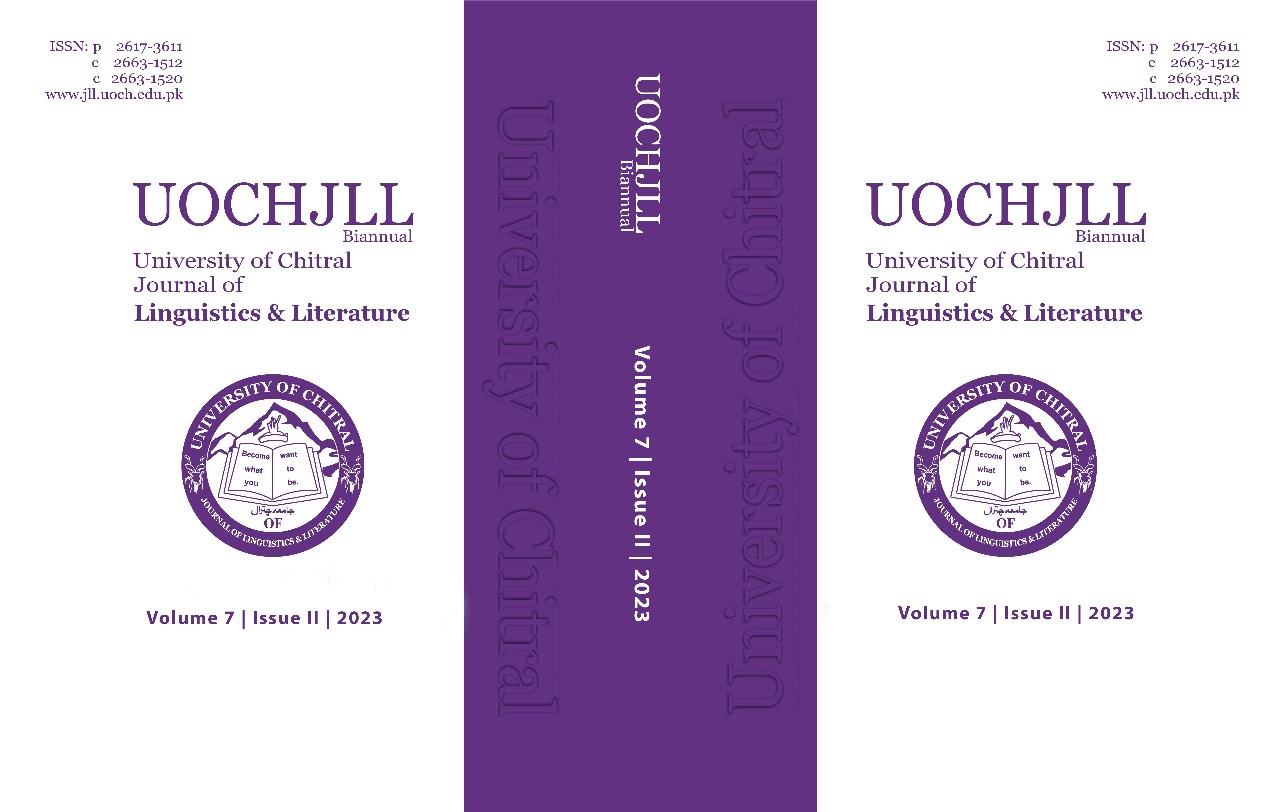Muteness and Oppression of Women in The Wasted Vigil from the Perspective of Patriarchy and a Muted Group Theory
Keywords:
The Wasted Vigil, MGT, patriarchy, oppression, muteness, womenAbstract
In this research article, the focus is on the idea of Muteness and Oppression of Women in the novel, The Wasted Vigil (2008). Two theories, i.e., Patriarchy and A Muted Group have been employed as a theoretical framework for the research. This research is qualitative in nature. The objectives are designed to find and dissect the factors that contribute to social oppression and muteness. In the light of A Muted Group and Patriarchy Theories, the research attempts to expound the aspects of gender oppression, muteness and social marginalization. MGT, pioneered by scholars like Ardener and later elaborated by Kramarae, serves as a crucial lens through which the silencing of women was examined. Simultaneously, the patriarchal tenets discussed by Connell and hooks offer a space to explore the systemic hierarchy that marginalizes women. Excerpts from the novel depicted women as not merely passive victims but also strong and resistant, subverting yet remaining entrapped within male-dominated structures. The findings revealed that the women characters in The Wasted Vigil (2008) depict muted groups whose attempts at resistance were both courageous and paradoxically constrained by patriarchal discourse. Secondly, the portrayal of oppressive factors ranged from physical violence to institutional forms of control. While acts of resistance were observed, they frequently occurred within boundaries established by the dominant male society, thereby questioning the efficacy of such resistance. This investigation contributes masterfully to the discourse on gender inequity and social oppression, employing meticulous textual analysis supported by influential theoretical paradigms.
References
Akgul, F. (2017). Patriarchal theory reconsidered: Torture and gender-based violence in Turkey. Springer.
Applin, S., Simpson, J. M., & Curtis, A. (2023). Men have gender and women are people: A structural approach to gender and violence. Violence against women, 29(5), 1097-1118.
Ardener, E. (2008). Belief and the problem of women and the ‘Problem Revisited. Feminist anthropology: A reader, 31-65.
Abar, I. M., Mazlini, W., & Waham, J. J. (2019). Patriarchal Oppression and Gender Discrimination in Selected Novels of Alice Walker. Malaysian Journal of Social Sciences and Humanities (MJSSH), 4(3), 85-92.
Butler, J. (2004). Performative acts and gender constitution. The performance studies reader, 154-166.
Butler, J. (2020). Performative acts and gender constitution: An essay in phenomenology and feminist theory. In Feminist theory reader (pp. 353-361). Routledge.
Belkhiri, Y., & Siham, A. Z. Z. I. (2019). Patriarchy and gender stereotyping in Khaled Hosseini’s A Thousand Splendid Suns (Doctoral dissertation).
Berkebile, J., & Lane, J. (2023). Muted Group Theory: Granting a Voice to the Voiceless Through" Wicked".
Cusack, C. M. (2020). The Theory of Equality: Patriarchy Disguised as Feminism. JL & Soc. Deviance, 20, 83.
Crane, R. J. (1996). ‘A Passion for History and for Truth Telling’: The Early Novels of Bapsi Sidhwa.
Connell, R. W. (2003). Scrambling in the ruins of patriarchy: neo-liberalism and men’s divided interests in gender change (pp. 58-69). VS Verlag für Sozialwissenschaften.
Crenshaw, K. (1991). Race, gender, and sexual harassment. s. Cal. l. Rev., 65, 1467.
Drydyk, J. (2021). Capability and Oppression. Journal of Human Development and Capabilities, 22(4), 527-550.
De Beauvoir, S. (1949). Woman as other. Social Theory, 337-339.
De Beauvoir, S. (1949). The second sex. Book One: Facts and Myths.
Egrikavuk, I. (2021). Seeing the Belly Dance as a Feminist Possibility: Gaze, Gender and Public Space in Istanbul. Cena, (33), 144-154.
Elgin, S. H. (1982). Women and Men Speaking: Frameworks for Analysis.
Funderburke, S. (2012). Operating the Silencer: Muted Group Theory in" The Great Gatsby". Liberty University.
Foucault, M. (1976). Histoire de la folie à l’âge classique. Gallimard.
Irigaray, L. (1985). The Power of Discourse and the Subordination of the Feminine (pp. 68-85). na.
Ifechelobi, J. N. (2014). Feminism: silence and voicelessness as tools of patriarchy in Chimamanda Adichie’s Purple Hibiscus. African Research Review, 8(4), 17-27.
Kaneohe, S. M., & Nomngcoyiya, T. (2016). An exploration of oppression of women among the communities practicing traditional male circumcision rite in Eastern Cape, South Africa. Journal of Human Ecology.
Khan. W. R & Faran. F. (2016). Hegemonic masculinity, muteness, and silence of the feminine voice in Khalid Husseini’s novel.
Ramzan, M., Khan, M. A., & Sarwar, M. (2023). Style Shift: A Comparative Cultural Analysis of Pride and Prejudice and Unmarriageable. University of Chitral Journal of Linguistics and Literature, 7(II), 22-29.
Downloads
Published
Issue
Section
License

This work is licensed under a Creative Commons Attribution 4.0 International License.
You are free to:
- Share — copy and redistribute the material in any medium or format for any purpose, even commercially.
- Adapt — remix, transform, and build upon the material for any purpose, even commercially.
- The licensor cannot revoke these freedoms as long as you follow the license terms.





